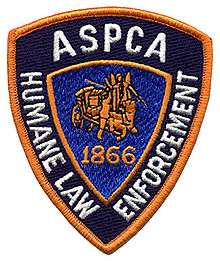Animal control service
An animal control service or animal control agency is an entity charged with responding to requests for help with animals ranging from wild animals, dangerous animals, or animals in distress. An individual who works for such an entity was once known as a dog-catcher, but is generally now called an animal control officer, and may be an employee or a contractor – commonly employed by a municipalities, county, shire[1] or other sub-national government area.
Duties and function

Animal control services may be provided by the government or through a contract with a humane society or society for the prevention of cruelty to animals. Officers may work for or, with police or sheriff departments, parks and recreation departments, and health departments by confining animals or investigating animal bites to humans.
The most common requirements for this job is some prior experience handling animals on a farm, as a veterinary assistant or animal trainer.[2] Training is primarily on the job but some jurisdictions (like Virginia, North Carolina and Texas) require formal and continuing education[3] available from community colleges and trade associations. Some animal cruelty investigators are specially trained police officers,[4] the New York American Society for the Prevention of Cruelty to Animals (ASPCA) employs several Humane Law Enforcement Officers with some police powers; and throughout the United States this arrangement is becoming more common.
Animals may be returned to their owners, or transported to a veterinary clinic or animal shelter. Animals held in the shelter can be returned to their owners, adopted, released to the wild, held as evidence in a criminal investigation or euthanized.[5]
Active cruelty to animals may be an indicator of serious psychological[6][7] or violence problems.[8][9][10][10][11] Because of these links, in some places animal control officers have begun to look for and report on other issues.[12]
In politics
An American colloquialism labels an unpopular politician by saying that he or she "couldn't be elected dogcatcher". "Dogcatcher" is also used as shorthand for low-level political office.[13]
Most animal control officers are actually appointed by an executive authority.[13]
References
- ↑ "RANGER SERVICES / POUND / LOST YOUR CAT OR DOG?" Archived January 2, 2016, at the Wayback Machine., harvey.wa.gov.au
- ↑ "Entry Requirements", animalcontrol.org.nz
- ↑ VA Requirements, Code of Virginia
- ↑ "Requirements for Becoming an Animal Cruelty Investigator", criminaljusticeprograms.com
- ↑ Notaro, Stephen J. "Disposition Of Shelter Companion Animals From Nonhuman Animal Control Officers, Citizen Finders, And Relinquished By Caregivers." Journal Of Applied Animal Welfare Science 7.3 (2004): 181-188. Academic Search Premier. Web. 13 Mar. 2013.
- ↑ "Pet-Abuse.Com – Animal Cruelty". Pet-abuse.com. Retrieved 2010-03-17.
- ↑ https://www.washingtonpost.com/local/loudoun-program-underscores-the-link-between-domestic-violence-animal-abuse/2014/09/23/9c4f9512-432a-11e4-b47c-f5889e061e5f_story.htm
- ↑ Facts About Animal Abuse & Domestic Violence American Humane Association Accessed 12 November 2006
- ↑ "Domestic Violence & the Animal Abuse Link". Animaltherapy.net. Archived from the original on 2009-12-29. Retrieved 2008-11-06.
- 1 2 Felthous, Alan R. (1998). Aggression against Cats, Dogs, and People. In Cruelty to Animals and Interpersonal Violence: Readings in Research and Applications. West Lafayette, Indiana: Purdue University Press. pp. 159–167.
- ↑ Goleman, Daniel (1991-08-07). "Clues to a Dark Nurturing Ground for One Serial Killer". New York Times. Retrieved 2010-04-30.
- ↑ May Eriksen, Alanah (2008-09-16). "SPCA, CYF police each other's patches". New Zealand Herald. Retrieved 2008-09-29.
- 1 2 Beam, Christopher (5 November 2010). "Dog Race: Is dogcatcher actually an elective office?". Slate Magazine. Retrieved 6 November 2010.
External links
- National Dog Warden Association
- National Animal Care and Control Association
- Western Australian Rangers Association
- Animal Control Officers FunStop